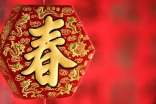- 相关推荐
2018年春节民风民俗资料大全
守岁、压岁钱、庙会、年夜饭……过去的几千年中,传统的春节民俗绵延至今,并通过自下而上的表现形式表达了人们内在的情感需求。但随着时代的发展,人们在保持这些传统风俗的同时,也给节日注入了一些新元素,形成了新民俗。一起来看看我国各地的民俗资料,希望对大家了解春节习俗有帮助!

春节初一到十五风俗介绍
正月初一,不能动用扫帚,否则会扫走运气、破财。假使非要扫地不可,须从外头扫到里边。
到今天许多地方还保存着一习俗,除夕前扫除干净,年初一不出扫帚,不倒垃圾,备一大桶盛废水,当日不外泼。
大年初二,出嫁的女儿回娘家,要夫婿同行,所以俗称“迎婿日”。
这一天,回娘家的女儿必须携带一些礼品和红包,分给娘家的小孩,并且在娘家吃午饭,但必须在晚饭前赶回婆家。在过去,一家人也会选择这一天拍张全家福。
大年初三,又称赤狗日,与“赤口”同音,通常不会外出拜年,传说这天容易与人发生口角争执。
不过这个习俗早已过时,因为现在人们难得春节团聚,对此已经淡化许多。
大年初四,是祭财神的日子,过去,老板想将某人“炒鱿鱼”,这天就不请他来拜神,对方也就心知肚明,自个收拾走人。
还有传说说,灶王爷这天要来查户口,因此也不宜远出。
正月初五,俗称破五,要“赶五穷”,包括“智穷、学穷、文穷、命穷、交穷”。
人们黎明即起,放鞭炮,打扫卫生。
鞭炮从里往外放,边放边往门外走。
说是将一切不吉利的东西都轰将出去。
这天,民间通行的食俗是吃饺子,俗称“捏小人嘴” 。
年初六,商店酒楼才正式开张营业,而且要大放鞭炮,不亚于除夕的境况。
传说这一天最受欢迎的是当年满12岁的男孩,因为12是6的二倍,这叫六六大顺。
这一天,每家每户要把节日积存的垃圾扔出去,这叫送穷鬼。
初七是人日,即人的生日。
根据《占书》记载,由初一开始,上天创造万物的次序是“一鸡二狗、三猪四羊、五牛六马、七人八谷”,所以初七就是人日。这天,市民喜欢吃及第粥,所谓及第,是希望科考状元高中。
初八是谷日,传说是谷子的生日,也叫顺星节,传说是诸星下界的日子,天空星斗出得最全,如果这天天气晴朗,则预示这一年稻谷丰收,天阴则年歉。
农历大年初九,民间习俗是玉皇大帝的诞辰,要举行盛大的祭天活动。台湾新竹不少信众要到主祀玉皇大帝、拥有二百多年历史的天公坛,向天公祝寿,并且祈求新的一年风调雨顺、平安健康。
初十,是石头的生日,这一天凡磨、碾等石制工具都不能动,甚至要祭祀石头。
在山东郓城等地有抬石头神的说法。
初九夜,人们将一瓦罐冻结在一块平滑的大石头上,初十早晨,用绳系住瓦罐的鼻子,由十个小伙子轮流抬着走,石头不落地则预示当年丰收。
正月十一,是“子婿日”,是岳父宴请女婿的日子。
初九庆祝“天公生日”剩下的食物,除了在初十吃了一天外,还剩下很多,所以娘家不必再破费,就利用这些剩下的'美食招待女婿及女儿,民歌称为“十一请子婿” 。
过了正月十一,人们开始准备庆祝元宵佳节,从正月十二开始选购灯笼,搭盖灯棚。童谣是这么唱的:“十一嚷喳喳,十二搭灯棚,十三人开灯,十四灯正明,十五行月半,十六人完灯。” 正月十五就是“元宵节”了,它是一年中第一个月圆之夜,也是大地回春的夜晚,又称为“上元节”。元宵燃灯的风俗起自汉朝,这一天少不了还要吃元宵、汤圆。正月十六夜则是小孩的节日,所有的小孩拿出自己的灯笼对着别人的重重一撞,然后笑哈哈的看着别人的灯笼着火,这个叫做“碰灯”。讲究的是今年的灯笼不能留到明年,必须以“碰灯”的方式销毁。
春节风俗英文简介
New Year celebrations is a grand event of China. New Year festivities lasts for one month in China. Chinese New Year is also called Spring festival. It begins from the middle of the last month of the year and ends up in the first month of the new year. These last day celebrations in China is called Lantern Festival。
History of Chinese New Year
追溯历史:名叫“年”的怪兽
Chinese New Year has a very interesting and unique history. According to theChinese legends, there was a giant beast Nian who used to swallow humans in a single bite. Relief from the horrifying beast came only when people realized that Nian was scared of red color and loud noises.They started bursting cracker sand used red color to scare the beast. Since then, this day was named as GuNian meaning "Pass over the Nian". Chinese considered the day an auspicious one as it brought new life for them and celebrated it as a New Year。
Chinese New Year Dates
农历新年,年年不同(生肖)
Chinese New Year falls on a different date every year. Chinese calendar is a combination of solar and lunar calendar. Chinese New Year falls on second new moon after the winter solstice(冬至). Chinese calendar has a 12 year cycle and each year is named after animal. Chinese believe that every person resembles an animal and this reflects their traits. Year 2017 was the Year of the Rooster.
Chinese New Year Celebrations
新年找乐,日日不同
Lot of excitement can be seen in the last 15 days of New Year celebrations. Every day has a special importance to it. Chinese ritualize and celebrate each day in a customary manner. Given below are the line wise celebrations of the New Year in China:
年初一:祭拜天地
Day1: People began their day by offering prayers and welcome the gods of heaven and earth. Most of the people stay away from meat to ensure healthy living。
年初二:祭祖祭神
Day 2:Successively, prayers are offer to their ancestors and other gods.
初三初四:走亲访友,媳妇回娘家
Day3 and 4: These are very important days for the families to keep up their relations. It calls for every son-in-law to pay respect to their parents-in-law。
年初五:“破五”祭财神
Day5: According to the traditions, nobody visits friends and relativeshouses as it would bring bad omen. They stay back home to worship the God of wealth. The day is called Po Woo。
年初六:百无禁忌,出门活动筋骨
Day6: On this day, people freely meet their near and dear ones and even visit nearby temples to pray for their well being and high spirits。
年初七:吃面条,祝长寿
Day 7: This is Chinese farmers' day. They display their backbreaking produce. They also prepare a drink from seven different types of vegetables. On this day, everybody eats noodles which is a symbol of long life and fish representing success。
年初八:凌晨拜天公
Day8: It's an other day to be celebrated with the family and friends. They also offer midnight prayers to Tian Gong, the God of Heaven。
年初九:玉皇大帝登场
Day 9: Prayers are offered to Jade Emperor。
初十、十一、十二、十三:大吃大喝,最后记得回归清淡
Days 10 to 13: From 10 to 12, people celebrate the days by having sumptuous dinner with the loved ones and the 13th day is left for a very light dinner to cleanse the system。
年十四:准备闹元宵
Day 14: People start preparing for the celebration of Lantern Festival to be held on next day。
年十五:吃元宵看灯火
Day 15: Since it is the first night to see full moon, people hang out colorful lanterns, eat glutinous rice balls and enjoy the day with their family.
【春节民风民俗资料】相关文章:
资料员隐蔽资料有哪些09-18
演讲训练资料09-05
小升初备考资料10-14
初级日语资料08-28
汉字来历的资料07-20
冬至资料集锦10-09
小升初需要的资料09-02
韩国留学必备民俗常识07-28
韩国留学的民俗风情07-18
小升初必备语法资料08-17